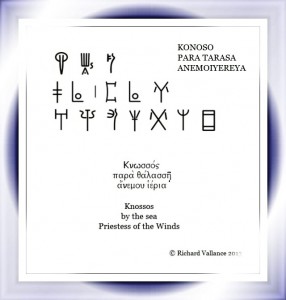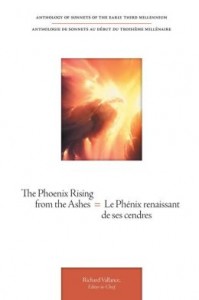Tiré de = from:The Phoenix Rising from the Ashes:
Anthology of sonnets of the early third millennium
= Le Phénix renaissant de ses cendres :
Anthologie de sonnets au début du troisième millénaire.
Victoria, British Columbia: Friesen Press, © 2013 /
Chapitre 2 : sonnets en français
Sonnet 53
d’après le Sonnet LIII (53) de William Shakespeare
Alexandrin
Laquelle serait l’essentielle à te définir,
Des ténèbres innombrables qui te poursuivent ?
Parmi ces pénombres qui veulent se réunir
À toi, à qui est la mine plus inexpressive ?
Décrire Adonis, et son image dans la glace
Veut te contrefaire aussi bien qu’il t’affaiblit ;
Les beaux-arts, auraient-ils, Hélène, autant de grâce,
Que la frise hellénique, elle qui t’embellit ?
L’on voit au beau printemps s’épanouir l’année,
Dont la foison est trop exquise et un atout,
Mais elle a moins d’abondance que ta Beauté ;
Te voilà donc bénie et reconnue partout.
Qu’elle soit prévisible, la grâce t’appartient,
Et la constance imprévisible aussi bien.
Richard Vallance
Le Sonnet 53 de Richard Vallance a été publié dans le vol. 7, numéro 3, été 2007, page 18 de Sonnetto Poesia ISSN1705-4524= was previously published in Sonnetto Poesia ISSN 1705-4524.Vol. 7 No. 3 summer 2007, page 18
Dit-il : Cette nouvelle version du sonnet que j’ai composé en français ne constitue
pas du tout une simple traduction. C’est en effet ma création originale du sonnet 53
de William Shakespeare (1564-1616). My version of William Shakespeare's Sonnet
53 is simply not to be construed as a running translation of the original. It is in fact
my own original creation.
Sonnet LIII
What is your substance, whereof are you made,
That millions of strange shadows on you tend?
Since every one hath, every one, one shade,
And you, but one, can every shadow lend.
Describe Adonis, and the counterfeit
Is poorly imitated after you;
On Helen’s cheek all art of beauty set,
And you in Grecian tires are painted new:
Speak of the spring and foison of the year;
The one doth shadow of your beauty show,
The other as your bounty doth appear;
And you in every blessed shape we know.
In all external grace you have some part,
But you like none, none you, for constant heart.
William Shakespeare (1564-1616)
Commentaires sur la recréation du sonnet 53 de William Shakespeare par Richard Vallance =
Comments on Richard Vallance’s recreation of William Shakespeare’s Sonnet 53 into French:
Ta recréation du sonnet de Shakespeare, fort réussie, me touche d’autant plus que...
passim... [j]e viens de comparer d’un peu plus près ton sonnet 53 avec l’original...
passim... et les traductions d’Henri Thomas et Armel Guerne. Si tu t’éloignes parfois
délibérément de la lettre, tu saisis l’esprit des Sonnets de Shakespeare, en particulier
la musicalité et les antithèses, dont celle de la chute. (Thierry Guinhut, France.)
http://www.thierry-guinhut-litteratures.com/)
Translated: Your recreation of Shakespeare’s sonnet, a success in itself, affects me all
the more when I compare it with the translations of Henri Thomas and Armel Guerne.
If you occasionally stray from the letter, you never stray from the spirit of Shakespeare’s
sonnets. Your French faithfully reflects the musicality, the play on antithesis and the
surprising twist of his rhyming couplet.
Had Richard Vallance only carried the images of Sonnet 53 safely across the pond to lay
them down in new Alexandrine accommodations, his achievement would have been notable;
but he has done something rarer... by reminding us of the Sonnet’s intentions. He has given
us a love poem: one that no Dark Lady would easily resist. (Becca Menon, Becca Books, NYC)
I read your translation/adaptation of sonnet 53 and enjoyed it ― a strange effect of translations
is sometimes one understands an aspect of the original better in the translation; Shakespeare’s
already moderately remote from us, that is our use of the English. So your translation brings
several aspects of the original to light which are perhaps a bit opaque in the original.
(Howard Giskin, Department of Modern and Classical Languages, University of Connecticut, Storrs)
Vraiment la traduction du sonnet 53 de W.S. est excellent. Je peux te dire qu’en français ça coule avec une douceur infinie. C’est de toute beauté. Gilles Le Chasseur (Rimouski, Québec, Canada)
Translated: Your translation of W.S.'s Sonnet 53 is excellent. I can honestly say
that it flows with infinite grace in French. It is a thing of beauty.
We urge readers of these sonnets in Poetry Life & Times pre-published
from The Phoenix Rising from the Ashes = Le Phénix renaissant de ses cendes.
Victoria, B.C., Canada, Friesen Press, © June 2013 300 sonnets in English,
French, German, Chinese & Farsi, http://vallance22.hpage.com/, to visit the
site. Readers may also contact Richard Vallance, Editor-in-Chief, at:
vallance22@gmx.com for further information.



